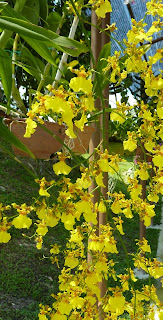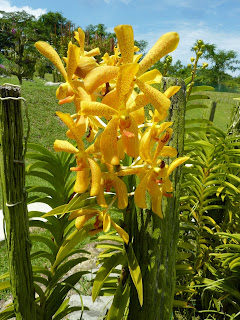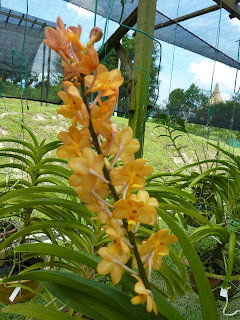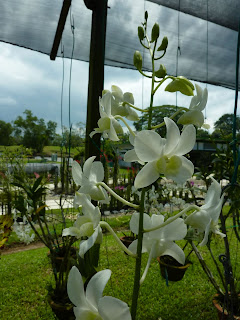Asparagus
===================================================================
Please refer to wikipedia for full text. Below are "key" excerpts from wikipedia for ease of reference.
http://en.wikipedia.org/wiki/Asparagus
Biology
Asparagus is a herbaceous, perennial plant growing to 100–150 centimetres (39–59 in) tall, with stout stems with much-branched feathery foliage. The "leaves" are in fact needle-like cladodes (modified stems) in the axils of scale leaves; they are 6–32 millimetres (0.24–1.3 in) long and 1 millimetre (0.039 in) broad, and clustered 4–15 together. The root system is adventitious and the root type is fasciculated. The flowers are bell-shaped, greenish-white to yellowish, 4.5–6.5 millimetres (0.18–0.26 in) long, with six tepals partially fused together at the base; they are produced singly or in clusters of 2–3 in the junctions of the branchlets. It is usually dioecious, with male and female flowers on separate plants, but sometimes hermaphrodite flowers are found. The fruit is a small red berry 6–10 mm diameter, which is poisonous to humans.[5]
Culinary
Asparagus is low in calories [12] and is very low in sodium. It is a good source of vitamin B6, calcium, magnesium and zinc, and a very good source of dietary fiber, protein, vitamin A, vitamin C, vitamin E, vitamin K, thiamin, riboflavin, rutin, niacin, folic acid, iron, phosphorus, potassium, copper, manganese and selenium[13][14], as well as chromium, a trace mineral that enhances the ability of insulin to transport glucose from the bloodstream into cells[citation needed]. The amino acid asparagine gets its name from asparagus, as the asparagus plant is rich in this compound.
Medicinal
Nutrition studies have shown asparagus is a low-calorie source of folate and potassium. Its stalks are high in antioxidants. "Asparagus provides essential nutrients: six spears contain some 135 micrograms (μg) of folate, almost half the adult RDI (recommended daily intake), 20 milligrams of potassium," notes an article in Reader's Digest. Research suggests folate is key in taming homocysteine, a substance implicated in heart disease. Folate is also critical for pregnant women, since it protects against neural tube defects in babies. Several studies indicate getting plenty of potassium may reduce the loss of calcium from the body.
Particularly green asparagus is a good source of vitamin C. Vitamin C helps the body produce and maintain collagen, the major structural protein component of the body's connective tissues.
"Asparagus has long been recognized for its medicinal properties," wrote D. Onstad, author of Whole Foods Companion: A Guide for Adventurous Cooks, Curious Shoppers and Lovers of Natural Foods. "Asparagus contains substances that act as a diuretic, neutralize ammonia that makes us tired, and protect small blood vessels from rupturing. Its fiber content makes it a laxative, too."
Cultivation
Since asparagus often originates in maritime habitats, it thrives in soils that are too saline for normal weeds to grow. Thus, a little salt was traditionally used to suppress weeds in beds intended for asparagus; this has the disadvantage that the soil cannot be used for anything else. Some places are better for growing asparagus than others. The fertility of the soil is a large factor. "Crowns" are planted in winter, and the first shoots appear in spring; the first pickings or "thinnings" are known as sprue asparagus. Sprue has thin stems.[19]
===================================================================
Yes, asparagus do grow in tropical climate. It will grow best in loose, organic rich soil. Asparagus need partial or full sun and sufficient soil moisture to encourage shoots formation.
The tricky part is getting the seeds to germinate. The germination rate seems to be extremely poor, with the seeds viability diminishing greatly over time. I only manage to germinate 4 seedlings out of 30 seeds in the initial stage. Unfortunately I lost 2 seedlings due to snails! I have tried to germinate more seedlings periodically with no success. I suspect the seeds viability.
The two 3 years old surviving plants are male plants. If only I can get one female plant. Then I will have my own fresh viable seeds for propagation. I will keep trying.
Three year old asparagus plant. The foliage looks unkempt due to over-crowding. There are also some yellowing of branches and leaves due to caterpillars and grasshoppers attack. The foliage needs to be thinned for easier pest control. The foliage need to be supported by stakes and wires.
Asparagus stems/shoots. Each clump should be allowed to have only 2~3 foliage producing stems to avoid overcrowding.
Each clump can be digged up and propagated as a new plant, but as tempting as it is, due to no prior experience it is not a risk I am willing to take. It took three years to coax the asparagus plant to form the clumps. Each clump is a shoots producing nexus.
My goal is to continue to establish new clumps outwardly to increase the harvest. Currently, the two plants yield about a dozen shoots weekly.
Just another small fry scalping for pittance in a sea of sharks. ikan bilis main kupiao was originally to log kupiao matters of interest, but now houses what-not of interest.
Sunday 21 August 2011
Thursday 18 August 2011
Flora : Orchid
A visit to the orchid garden
...in pictures
...in pictures
The orchid garden is located across Sungai Sarawak opposite the Kuching Waterfront. In the backdrop is the DUN Sarawak.
On display in the garden are a myriad of orchids of different family and genus, some common, some not so common. Unless you are an orchid buff, trying to identify the family or genus will make you go bonker.
The garden was still in expansion mode at the time of visit, and not all orchid plants were in bloom. But the hours fly by rather quickly when you take the time to admire the blooms and click away.
So... just enjoy the blooms and soak in the colours. Don't bother yourself with the names.
Wednesday 10 August 2011
Epulae : Railway Cottage Cafe
Railway Cottage Cafe
"X" mark the location. Along what was known as Jalan Keretapi to those senior enough to remember.
p/s: Images of dishes below are courtesy of CY.T.
Butter Fish Rice (RM7.90)
Chicken Cordon Blue (RM17.90)
Curry Chicken Rice (RM6.90)
Fish & Chips (RM14.90)
Fried Squid and Fish Fingers with Fries (RM9.90)
Heng Hua Noodle Soup (RM5.90)
Lamb Chop with mushroom sauce (RM16.90)
Lamb Chop with pepper sauce (RM16.90)
Mixed Vegetable Rice (RM6.90)
Napolitano Chicken Meatball Spaghetti (RM12.90)
Onion Rings (RM3.90)
Sirloin Steak (RM19.90)
Portion: Cat size
Ambient: Cosy
Verdict:
Recommendation? Yes, worth a visit. Reasonable pricing with sufficient portions and agreeable flavours to palates.
"X" mark the location. Along what was known as Jalan Keretapi to those senior enough to remember.
p/s: Images of dishes below are courtesy of CY.T.
Butter Fish Rice (RM7.90)
Chicken Cordon Blue (RM17.90)
Curry Chicken Rice (RM6.90)
Fish & Chips (RM14.90)
Fried Squid and Fish Fingers with Fries (RM9.90)
Heng Hua Noodle Soup (RM5.90)
Lamb Chop with mushroom sauce (RM16.90)
Lamb Chop with pepper sauce (RM16.90)
Mixed Vegetable Rice (RM6.90)
Napolitano Chicken Meatball Spaghetti (RM12.90)
Onion Rings (RM3.90)
Sirloin Steak (RM19.90)
Portion: Cat size
Ambient: Cosy
Verdict:
Recommendation? Yes, worth a visit. Reasonable pricing with sufficient portions and agreeable flavours to palates.
Sunday 7 August 2011
Flora : Azalea
Azalea
Bought on a CNY eve night two years back during a clearance sale at a decent discount. Did not expect it to outlive the CNY period but it did :)
The plant is now thrice the original size. Did a lot of trial and error with the plant. The most fatal mistake will be to add lime or re-pot into alkaline soil. This is an acidic soil loving plant. The whole plant will die back rather quickly if not re-potted into acidic soil.
A less fatal mistake will be to over-water the plant. Azalea dislike wet feet. Water logging or constantly damp soil will cause leaves to yellow and drop, and the branches die back one by one. Water the plant every other day or once every 3 days i.e. allows the soil to reasonable dry up in between watering. Mulch the soil to retain moisture.
Other pointers to keep an azalae plant happy in an equatorial climate...
A light application of organic compost once a month will keep the plant growing healthily and full of blooms.
Azalae loves a mist spray every early morning. This keep the flowers blooming for longer period.
Direct sun light will scale the leaves and flowers.
Partial sun light will also scale the leaves and flowers but to a lesser extend.
Even in shade, low humidity and high temperature can scale the leaves and flowers.
I sat the azalae pot in a pot tray filled with pebbles and water. The pebbles prevent the pot from sitting in the water, and the water provides humidity to the ambient surrounding the azalae plant.
I also placed shady, towering plants and shrubs surrounding the azalae to provide further humidity and cooler ambient.
Only very light trimming is required once in a while. Mainly to remove spent flowers and the occasional browned leaves in the undergrowth.
It took a while for me to understand the azalae's needs, but it's worth it. The azalea is now thriving happily in its little cosy corner with minimum TLC from me.
Bought on a CNY eve night two years back during a clearance sale at a decent discount. Did not expect it to outlive the CNY period but it did :)
The plant is now thrice the original size. Did a lot of trial and error with the plant. The most fatal mistake will be to add lime or re-pot into alkaline soil. This is an acidic soil loving plant. The whole plant will die back rather quickly if not re-potted into acidic soil.
A less fatal mistake will be to over-water the plant. Azalea dislike wet feet. Water logging or constantly damp soil will cause leaves to yellow and drop, and the branches die back one by one. Water the plant every other day or once every 3 days i.e. allows the soil to reasonable dry up in between watering. Mulch the soil to retain moisture.
Other pointers to keep an azalae plant happy in an equatorial climate...
A light application of organic compost once a month will keep the plant growing healthily and full of blooms.
Azalae loves a mist spray every early morning. This keep the flowers blooming for longer period.
Direct sun light will scale the leaves and flowers.
Partial sun light will also scale the leaves and flowers but to a lesser extend.
Even in shade, low humidity and high temperature can scale the leaves and flowers.
I sat the azalae pot in a pot tray filled with pebbles and water. The pebbles prevent the pot from sitting in the water, and the water provides humidity to the ambient surrounding the azalae plant.
I also placed shady, towering plants and shrubs surrounding the azalae to provide further humidity and cooler ambient.
Only very light trimming is required once in a while. Mainly to remove spent flowers and the occasional browned leaves in the undergrowth.
It took a while for me to understand the azalae's needs, but it's worth it. The azalea is now thriving happily in its little cosy corner with minimum TLC from me.
Subscribe to:
Posts (Atom)








